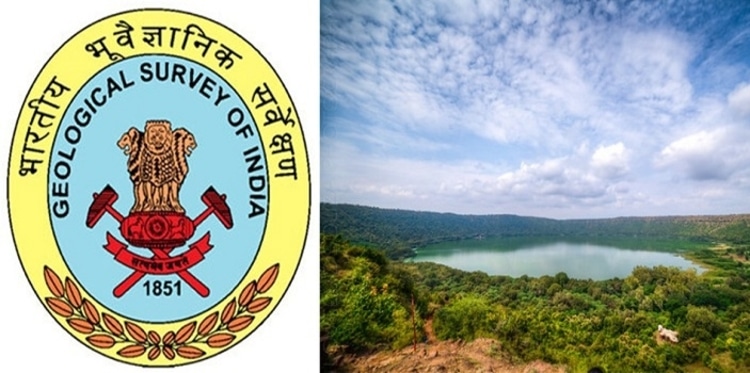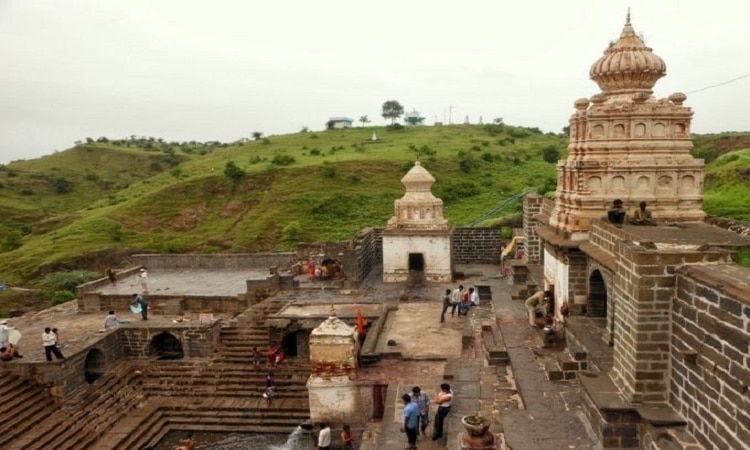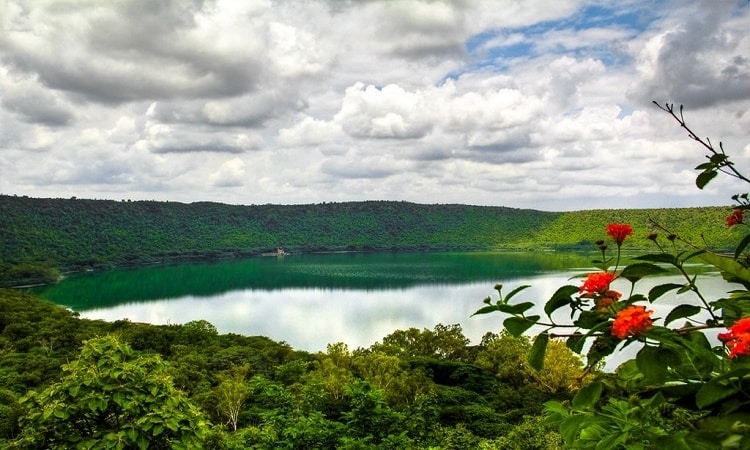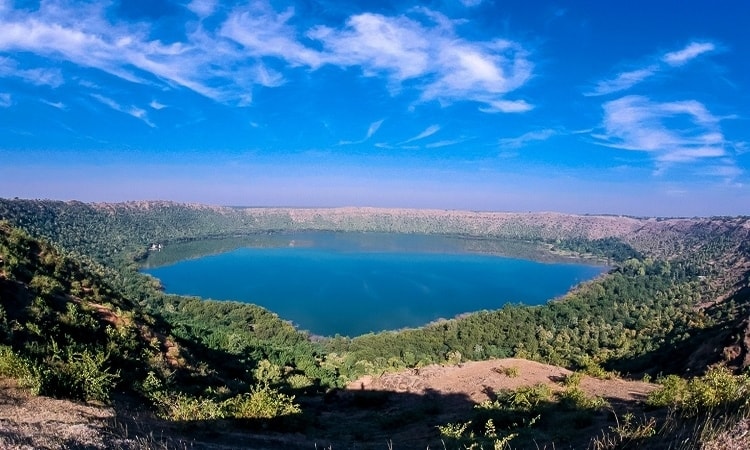India is a land of beauty, mystery, and worldliness. The charm of India is prevalent everywhere around the country and not just on the known trails. This gets proved by our very own “Lonar Crater – The Bowl of Mystery” located in the Buldhana district of Maharashtra.
Well, we are talking about a place on earth which is more than 50,000 years old and is said to be formed when a meteor hit this spot in Lonar and created a 1.8 km wide crater. Sounds like a science fiction story? Yes, the place was hit by a meteor and the crater formed by this meteorite strike is now a saline lake. Though it has been classified as a national geological heritage site by the Geological Survey of India (GSI) what makes this place historically special is that it is known to be a meteoric crater!
This lake is Earth’s largest and only saltwater lake in basaltic rock. Also, the lake is both saline and alkaline at the same time. This astronomical marvel is home to rich flora and fauna and unique natural surroundings with its dense forests. Each part of this region is considered unique and the lake itself is the “Bowl of Mysteries”. The lake has triggered many questions and theories that are beyond understanding. It’s a meteor mystery that has intrigued many researchers, astronomers, geologists, ecologists, and even NASA.
So, let’s find out more about this unique marvel where science meets religion. We’ll take you on a journey to this tranquil, offbeat yet surprising spot and its mysteries and facts through this article.
About the Lonar Lake
Lonar Crater Lake is a unique, tranquil and appealing geological marvel ringed with a thick green cover and is dotted with several temples around its fringe. It is considered to be more than 52,000 years old. It is the only Hyper-Velocity Crater on Earth. It was formed in the Deccan Plateau’s hard basalt rock, the only of its kind on Earth. During the Ice Age, a large meteoroid weighing 2 million tons crashed into this part of earth at an extreme speed of 90,000 km/hr. The hypervelocity impact led to a massive crater formation in the basaltic rock that is 1.8 km wide and 150 meters deep. This mystical Lake is located in the suburbs of Lonar Town in Buldhana district of Maharashtra. Aurangabad is the nearest major railway station for the lake.

Lonar Lake has been declared as a Wildlife Sanctuary for the conservation and conservation of Lonar lake. Organizations such as the Smithsonian Institution, United States Geographic Survey in America and the Geological Society of India, Physical Research Laboratory of India have done a lot of research on this lake. Lonar Lake is also significant because it is both alkaline and saline at the same time. The pH of lake water is 10.5, which makes the lake water highly alkaline.
Historical Facts
The lake was first brought to notice in 1823 by British officer C.J.E. Alexander. In 1896, American geologist G.K. Gilbert conducted studies to prove that Lonar was created due to meteor strike.
A further study conducted on the spot under the leadership of Prof. K. Fredrikson by officials of Geological Survey of India, United States Geological Survey and other institutions, proved that the lake was created by a meteor hit 50,000 years ago.
The lake was first mentioned in ancient scriptures such as the Skanda Purana, the Padma Purana, and the Ain-i-Akbari.
During the days of Emperor Akbar, a salt factory was located here, The Ain-i-Akbari, written about 1600 CE, states: The place produced all the requisites for making glass and soap. On these mountains is a spring of salt water, but the water from the centre and the edges are perfectly fresh.
Mythological Relevance
According to local belief, Lonar derives its name from the mythical demon Lonasura (also called Lavansura). This demon used to harass and trouble the local people so much that Lord Vishnu descended to earth to vanquish him. The crater, and the lake that now fills it was formed when Lonasura was pushed back into the hell with tremendous force by Vishnu! The son of Kashyap Rishi is said to have prayed to Lord Vishnu to kill Lonasura.
It is also believed that the Vishnu overpowered the demon-giant Lonasur by throwing off the lid and revealing his subterranean cave. The lake is considered to be the giant's blood, a nearby hill is the discarded lid and the crater is the remains of the cave.
The lake also has a reference as Panchapsar in the Valmiki Ramayan and has been later written about by the epic poet Kalidas, around 16 centuries ago. He had termed it as the lake Panchapsar in his famous text titled ‘Raghuvansh’.
Because of the historical name Panchapsar, it was traced that there are five streams that feed the lake.
According to mythological lore, it has been believed that when Lord Rama was flying on his way from Sri Lanka to Ayodhya, he showed a place to his beloved Queen Sita. Researchers suggest that Lord Rama was referring to this lake at Lonar.
Lonar has been a centre of worship too since the medieval age. In the 13th Century, Daitya Sudan Temple, dedicated to Lord Vishnu was constructed here during the Chalukya Raj. Inspired by the Lonasura folktale, one of the kings built this temple. The temple still exists and is 150m long and 450m wide. It is a fine example of the quality of architecture practiced and perfected during that era.
Other Interesting Facts
It is indicated that the meteorite hit this spot at an angle of 35 degrees to 40 degrees as the crater hosting the lake has an oval shape.
The slopes around the lake have multiple rings of trees. The trees stretch out to a distance of 1 mile. What is interesting is that each ring of tree is made up of a specific species of tree. For instance, the first and outermost ring is of date palms. Inside the date palm ring is the tamarind tree ring and inside it is a ring of babul trees.
The outer region is a neutral region with a pH level of 7. The inner region is the alkaline region with a pH level of 11. Both regions have unique and diverse flora and fauna.
The lake is also a spot for a wide variety of migratory and resident birds like swallows, robins, magpies, tailorbirds, larks, hoopoes, parakeet, baya weavers, blue jays, red-wattled lapwings, herons, teals, shovellers, shelducks, grebes, brahminy ducks, and black-winged stilts.
The fauna that inhabits the forests includes gazelle, langur, bats, mongoose, barking deer and chinkara along with snakes, scorpions, monitor lizards, and brilliantly coloured insects and amphibians.
Lonar is the third-largest natural salt-water lake in the world. The first one is Bosmatvi Lake in Ghana.
A recent study conducted by IIT Bombay found that the minerals in the lake soil are very similar to the minerals found in moon rock which was brought back during the Apollo mission.
Sadly, a few years ago, the Government of India changed the eco-sensitive zone around the lake from 500 meters to 100 meters. This has been done to allow commercial development of the surrounding areas. Conservationists suggest that this will disturb the fragile ecosystem of the area and will lead to its destruction. Seriously, necessary steps must be taken to prevent this geological marvel of remarkable significance.
It’s a magical and beautiful remnant of the celestial event that occurred thousands of years back. It’s a place where science fiction meets religion. Here’s the Google Earth image of the Lonar Crater:
So, if you are tired of the known tourist trails and want to get yourself lost in a unique, offbeat and mysterious place, then Lonar Crater Lake is a perfect option! Book your tickets through Trainman app. Download Trainman App and check PNR Status of the booked ticket, Running Status, Seat availability and much more.

In Hindu mythology, the place is considered important and has various legends associated with it.


The Lake triggered various questions that are still under research by various organizations. Some of the questions like - Why is the lake alkaline and saline at the same time? Why does it support micro-organisms rarely found anywhere else on Earth? Why do compasses fail to work here? And what lies at the bottom? Some of the experts believe that the meteorite is buried deep in the crater. Some of the other facts associated with the lake are:




